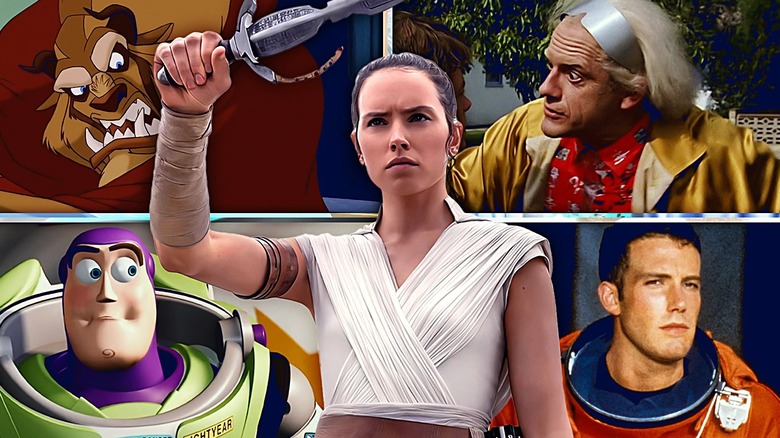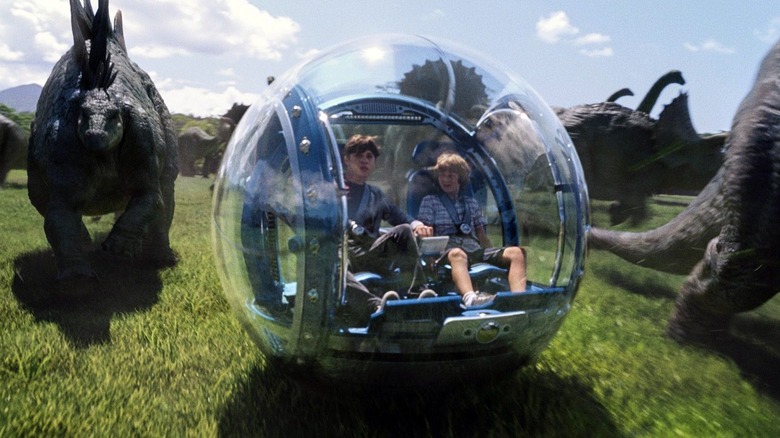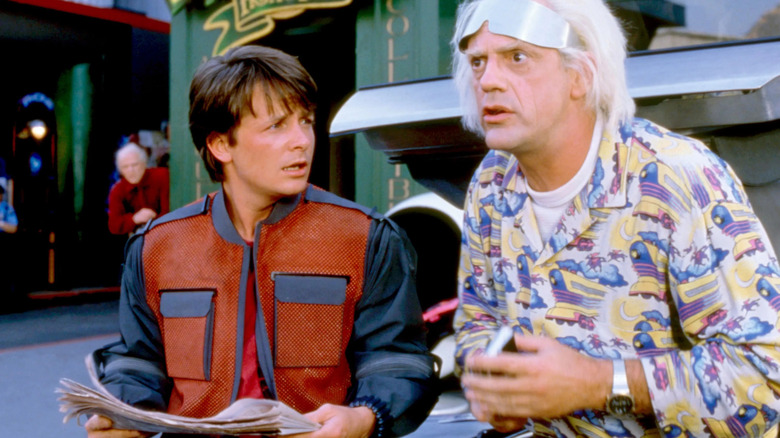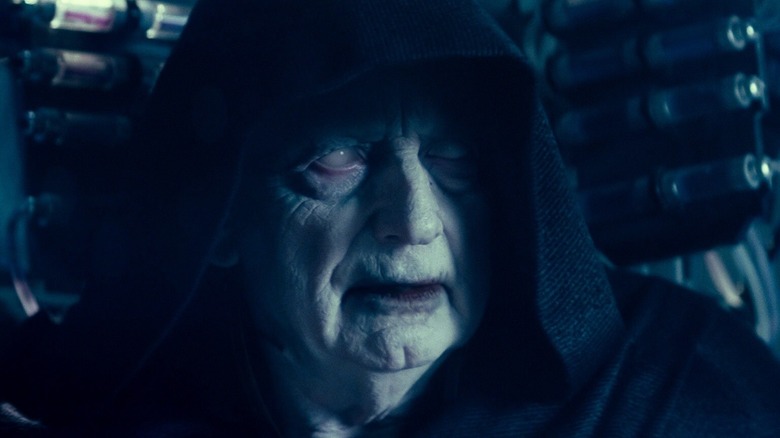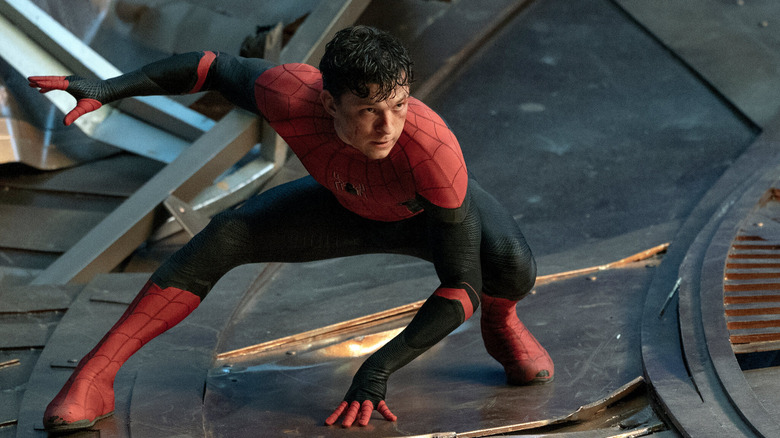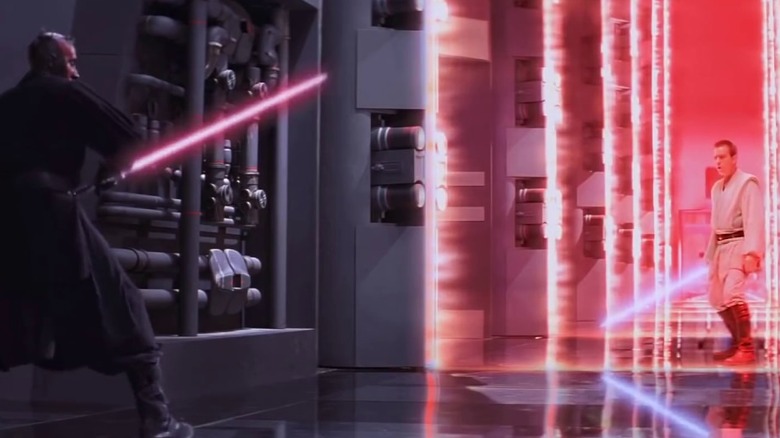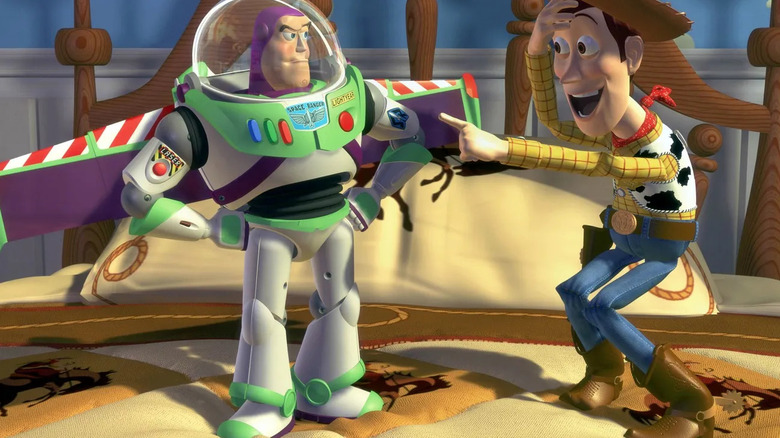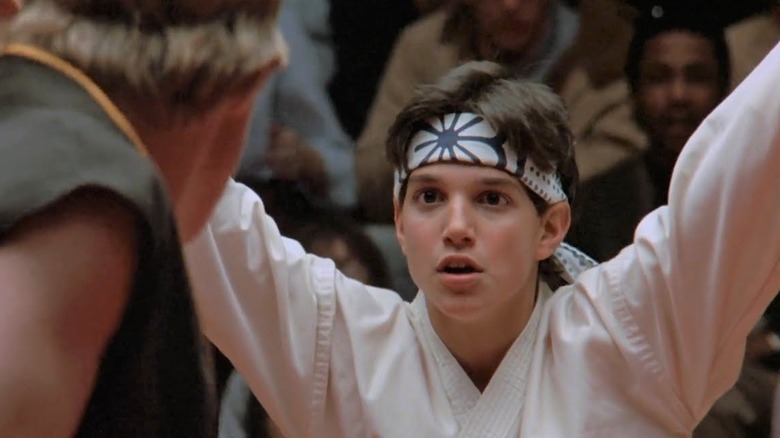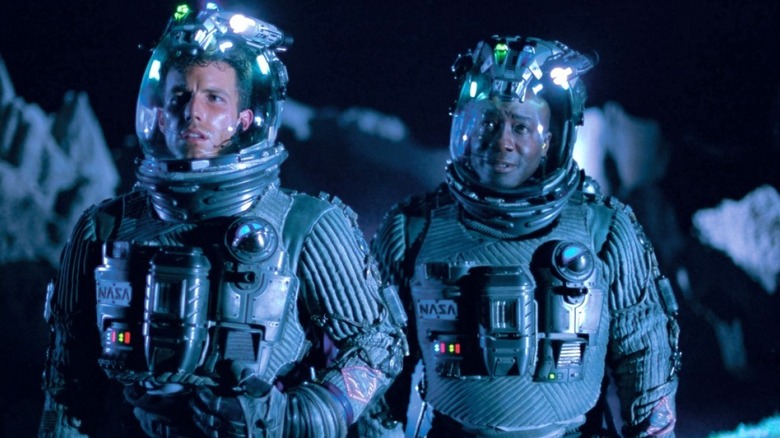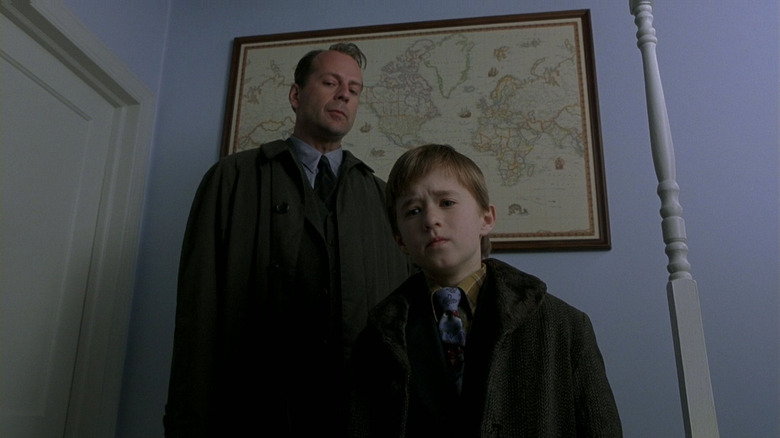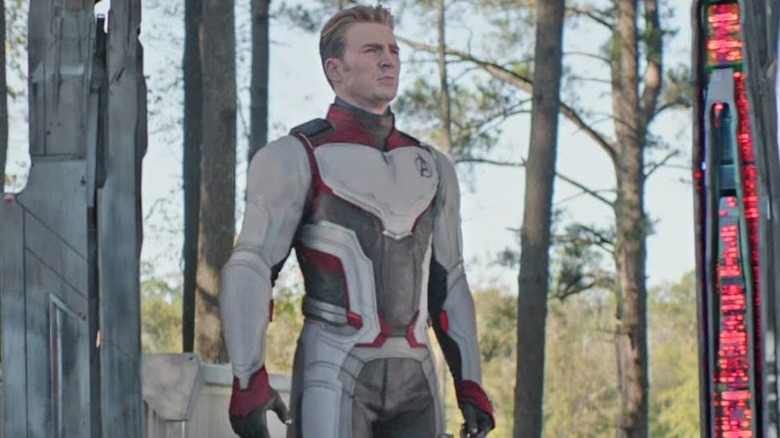12 Plot Holes That Completely Ruined Movies
Every movie has its flaws. Even classics like Steven Spielberg's "Jaws" and George Lucas' "Star Wars" stretch logic to achieve their storytelling goals, often to the amusement of audiences. "Close Encounters of the Third Kind" famously revealed its massive alien saucer during its magical finale by having it rise from behind Devil's Tower (rather than descend from space) simply because Spielberg thought it looked cool. Peter Jackson used a literal dead army to bring a swift end to the Battle of Minas Tirith in "The Lord of the Rings: The Return of the King," only to dismiss them before the final showdown at Mordor — where they really could have turned the tide against Sauron's forces.
These are minor nitpicks in otherwise stellar films.
Sometimes, though, a writer or director dips too far into absurd logic and creates a plot hole that undermines the entire story — perhaps even rendering it unwatchable. The following list highlights some of the worst offenders, though whether they ruin the film is entirely up to you. Read!
Gyrospheres - Jurassic World
"Jurassic World" has plenty of glaring issues that undermine an otherwise solid entry in the long-running franchise. Still, the most egregious flaw lies in the park's setup. "Jurassic Park" wisely placed visitors in automated cars on a track, presumably locking them inside during the tour. "Jurassic World," on the other hand, lets tourists roam open fields in giant hamster balls called Gyrospheres alongside real dinosaurs. Who thought this was a good idea?
Sure, the dinos are herbivores, but what's stopping some brat from playing chicken with a Triceratops? Or spooking a herd of Brachiosaurs into a stampede? And imagine a little old lady accidentally pissing off a Pachycephalosaurus, which proceeds to bash her to bits with its head.
Even dumber, Gray (Ty Simpkins) and Zach (Nick Robinson) manage to drive off-grid, slip through a broken fence, and into the old park without triggering any alarms. You'd think these vehicles would have a fail-safe or an auto-shutdown when entering a restricted zone. Heck, city scooters power down if you leave a designated area.
"Jurassic World" is a fully operational park. By this point, all the kinks should be ironed out. Yet somehow, two unsupervised kids can outwit a billion-dollar security system with ease. It's almost as if the people behind the film didn't give a crap, so why should we?
Time Travel Logic - Back to the Future Part II
Robert Zemeckis' "Back to the Future Part II" contains a plot hole that renders the whole film pointless. At the climax of "Back to the Future," Marty McFly (Michael J. Fox), having spent a week in 1955, travels back to 1985 with the help of Doc Brown (Christopher Lloyd). During his odyssey, he made several decisions that altered his future. He saves Doc from dying at the hands of the Libyans and guides his parents toward a more fulfilling life. Basically, Marty and Doc change their density, er ... destiny.
In the 1989 sequel, Marty heads to 2015 at Doc's behest to stop his kid from making a terrible mistake. Using an elaborate ruse, the pair accomplishes their task — but there was no need for any of it. By the rules established in the original film, Doc could have just visited Marty in 1985 and told him what was going to happen, thus negating the need to travel into the future.
Yes, a simple conversation would have saved a lot of time, and likewise would have prevented Biff (Thomas F. Wilson) from screwing up the space-time continuum, and spared audiences from having to endure "Back to the Future Part III."
Palpatine's Return - Star Wars: Episode IX - The Rise of Skywalker
The "Star Wars" films have never been renowned for their believability. Yet there are times when even this beloved franchise crosses the threshold from incredible fantasy adventure to plain dumb.
Case in point, "Star Wars: Episode IX — The Rise of Skywalker," the divisive finale (?) that capped off the adventures of Rey Palpatine, er ... Skywalker (Daisy Ridley). Her journey concludes similarly to Luke Skywalker (Mark Hamill) and Darth Vader (David Prowse) by vanquishing the dreaded Emperor Palpatine (Ian McDiarmid) once and for all. Hooray!
Oh, wait ... how did the Emperor return?
Therein lies the rub. The dreaded Sith Lord died at the end of "Return of the Jedi," and was MIA from "The Force Awakens" and "The Last Jedi," but conveniently reappears for the final chapter without an ounce of buildup. His appearance shocks everyone — including the audience — leading to the famous line by Poe Dameron (Oscar Isaac): "Somehow, Palpatine returned."
Yeah, that's basically the only explanation we get. Well, that, and the Emperor's claim that he was behind the events of the previous films all along. He was Snoke (Andy Serkis), and, er, uh ... yeah, we're still not sure what he's talking about.
Villain Gaffe - Spider-Man: No Way Home
The plot of "Spider-Man: No Way Home" finds a clever way to bring back several characters from previous "Spider-Man" films, including fan favorites Tobey Maguire and Andrew Garfield. We also get appearances from a slew of Spidey villains, notably Green Goblin (Willem Dafoe, who had a specific condition for his return), Doc Ock (Alfred Molina), Electro (Jamie Foxx), Sandman (Thomas Haden Church), and Lizard (Rhys Ifans).
Sounds amazing, right?
Well, the gist of the story is that Spider-Man (Tom Holland) wants to help these villains, who, we're told, all die by his hand — or, one of his other iterations. In fact, they were supposedly pulled into Earth-199999 right before the moment of their deaths. That plot line works for Green Goblin and Doc Ock, both of whom perished while fighting the webbed hero, and even for Electro, who overloaded himself in "The Amazing Spider-Man 2." But it doesn't work for Lizard or Sandman.
If memory serves, Lizard simply reverted to his human form and wound up in a jail cell at the end of "The Amazing Spider-Man," while Sandman drifted away after apologizing for nearly destroying the city in "Spider-Man 3." Neither character died.
Of course, you could hand-wave this by saying they're alternate versions of the villains, but if that's the case, shouldn't we have seen multiple Green Goblins, Doc Ocks, or Electros as well? And what about Topher Grace's Venom? He did die in "Spider-Man 3," yet he's nowhere to be found.
Sounds like Spider-Man is contradicting himself, kids.
Speed Run - Star Wars: Episode 1 - The Phantom Menace
Back to "Star Wars," because, honestly, we could write an entire article about the plot holes in this franchise, we now turn our attention to George Lucas' dreaded "The Phantom Menace."
Here, Jedi Obi-Wan Kenobi (Ewan McGregor) and Qui-Gon Jinn (Liam Neeson) battle an army aboard a Trade Federation ship. Together, they easily handle the attack, making mincemeat of the various droids that appear, all the while working their way toward the Viceroy. Then, a pair of Droidekas appear and proceed to launch a flurry of lasers in their direction. Outgunned, the Jedi opt to vacate the premises and speed off — and by speed off, we mean they turn into supermen and run faster than a speeding laser. Apparently, this is a thing Jedi can do.
Too bad Obi-Wan forgets this unique power when he and his master go toe-to-toe with Darth Maul (Ray Park) during the climax. During the battle, Obi-Wan becomes separated behind red force fields that briefly open every minute or so. Rather than use his Force speed run to aid his master, Obi-Wan twirls his lightsaber and jogs through the obstacle — leaving Qui-Gon to face Maul alone and ... well, we all know how that ended.
If you're going to introduce a super-cool power early in the film, George, you can't just disregard it for the sake of the plot.
Buzz Lightyear - Toy Story
Have you ever caught yourself overthinking the logic of "Toy Story?" Don't worry, you're not alone — we've spent countless nights trying to make Pixar's animated classic make sense. We still love the movie, but it always leaves us scratching our heads with its poorly thought-out setup.
Still, the biggest obstacle that never ceases to frustrate is none other than Buzz Lightyear (Tim Allen, who got the role over Jim Carrey and several others) himself. When he first arrives in Andy's room, Buzz is all business and genuinely believes he's a Space Ranger on a mission to Planet Zerg. He spends his free time fixing his spacecraft or trying to connect with headquarters to alert them of this strange new location.
Except, whenever Andy appears periodically to play with his odd assortment of action figures, Buzz reverts to his toy form. He doesn't speak or move, and allows this child to play with him ... like a toy.
What gives? Is there some sort of mission protocol that prevents Buzz from speaking in front of a human? Or is this merely a plot hole the writers conveniently overlook to keep the animated picture moving along? And yes, we understand the ridiculousness of worrying about the realism of a film featuring talking toys, but the filmmakers are clearly operating by a set of established rules they choose to disregard when it doesn't meet the story parameters.
Illegal Kick - The Karate Kid
If you've seen the stellar Netflix TV series "Cobra Kai," then this curious plot hole will come as no surprise. It all goes back to the original 1984 "Karate Kid," in which young Daniel LaRusso (Ralph Macchio) teams with karate expert Mr. Miyagi (Pat Morita) to take on a group of high school bullies led by Johnny Lawrence (William Zabka). This intense rivalry culminates at the All Valley Karate Tournament, where Daniel — surprise, surprise — squares off against Johnny in the final match.
After enduring the type of rule-breaking pain only Cobra Kai can deliver, Daniel rises to the challenge and uses the iconic crane kick to knock out Johnny and emerge victorious. Everyone, including Daniel's girlfriend (Elisabeth Shue), storms the stage, and we're left with a hefty dose of adrenaline powerful enough to level mountains.
The problem is, Daniel's kick shouldn't have counted. At the beginning of the tournament, the judge clearly states that hits to the face are illegal. And yet, somehow, they completely overlook their own guidelines to serve the needs of the plot. We could argue that many of Johnny's actions were illegal as well, but at least the judge issued warnings to Cobra Kai. Daniel, on the other hand, won by outright breaking the rules.
Perhaps that's why Mr. Miyagi looked slightly bemused in the final shot. Ironically, Daniel won by embracing Cobra Kai's own mantra — no mercy.
Oil Drillers - Armageddon
We love Michael Bay's "Armageddon" as much as the next guy. Sure, it's loud, dumb, overly dramatic, and corny as hell, but the 1998 disaster epic is also the perfect encapsulation of what made 1990s cinema so great — rock 'em, sock 'em action, unfiltered humor, and Aerosmith. Plus, you get Bruce Willis in top action hero form, a young Ben Affleck sporting newly minted porcelain veneers, a gorgeous Liv Tyler, Steve Buscemi, and plenty of rah-rah American imagery. Still, to enjoy the fun, viewers are forced to overlook a glaring flaw: the actual premise of the film.
For those unaware, "Armageddon" concerns a group of oil drillers who are tasked with destroying a meteor before it hits Earth. With just days until the impending disaster, NASA must train these roughnecks to be capable astronauts ... an idea that, well, is just plain idiotic. So idiotic, in fact, that Affleck pointed it out to Bay during production, as noted on his now-legendary DVD commentary: "I asked Michael why it was easier to train oil drillers to become astronauts than it was to train astronauts to become oil drillers, and he told me to shut the f*** up,"* Affleck said.
We get that most summer movies require one to check their brains at the door, but there's a point where a film crosses into too-dumb-to-enjoy territory.
The Prince's Age - Beauty and the Beast
Another '90s staple, and one of Disney's best animated films, "Beauty and the Beast" remains an all-time classic thanks to its gorgeous animation, terrific voice acting, memorable songs, and powerful depiction of true love conquering all. It truly is a remarkable tale (as old as time).
Regrettably, after so many viewings, we happened upon a little snag concerning the Beast (Robby Benson). At the beginning of the film, a prologue informs us that he was once a selfish young prince who shunned an enchantress disguised as an old woman on a rainy night. Consequently, the magical woman transformed the prince into the Beast, a guise he would hold forever unless he could make a woman fall in love with him before his twenty-first birthday.
Simple, eh? Well, fast-forward to the "Be Our Guest" sequence, where the cavalier candelabra Lumiere (Jerry Orbach) explains, "Ten years we've been rusting, needing so much more than dusting." Wait — that means the prince was only 11 years old when the Enchantress cursed him. And yet, in the prologue, he's clearly depicted as a grown man in several paintings — including the one the Beast slashes — and in stained-glass window art around the castle.
So, what gives? Was Lumiere exaggerating? Did the prince hire a blind painter? And really, what kind of Enchantress punishes an 11-year-old kid for acting like... well, an 11-year-old kid?
Malcolm's Personal Life - The Sixth Sense
M. Night Shyamalan rose to fame and box office glory with 1999's "The Sixth Sense," about young Cole Sear (Haley Joel Osment), cursed with the ability to see dead people. Child psychologist Malcolm Crowe (Bruce Willis) steps in to help — only for a late twist to reveal he's been dead all along, carrying on his routine unaware that no one, not even his wife (Olivia Williams), can see him. It's a clever rug pull that completely catches first-time viewers by surprise. Except, it falls apart if you think about it too hard.
See, Shyamalan relies on fridge logic, framing Malcolm in a way that fools the audience, but doesn't hold up logically. For example, when Cole sees Malcolm sitting silently with his mother (Toni Collette), the scene is staged to make us believe the two adults were just having a conversation. In reality, she can't see Malcolm at all. So what actually happened? Did he just let himself in, sit down at her table, and wait in silence for Cole to show up? How did he even set up this appointment or know when to arrive?
Likewise, how did he know to meet his wife at the restaurant? How does he enter places? What does he eat or drink? Where does he sleep? Does he change clothes?
Perhaps the twist was so novel at the time that we overlooked how it holds about as much water as Shyamalan's later, more ridiculed efforts.
Ariel's Strategy - The Little Mermaid
We're diving into the Disney Renaissance now — an era that thrived before audiences spent endless hours online ripping fairy tales to shreds. "The Little Mermaid" fits right in: a lively musical that glosses over plenty of logic gaps to keep the story moving. One nagging issue is Ariel (Jodi Benson) striking a deal with the sea witch Ursula (Pat Carroll): three days to win Prince Eric's (Christopher Daniel Barnes) love in exchange for her voice, or she becomes Ursula's property.
Ariel signs the agreement — proving she can write, in cursive no less — and then heads to the surface without her voice. She tries to win Eric over with her looks and, in Ursula's words, her "body language." Here's the problem: if Ariel can read and write, why doesn't she just grab a piece of parchment and a quill and explain her situation to Eric? Something like: "Hey, I'm the girl who rescued you. I need you to kiss me so I can get my voice back. I'll explain everything after."
That seems a lot easier than relying on elaborate musical numbers, and it might have saved everyone a lot of trouble. Had the writers established that mermaids don't write in human language, or that using writing was against the rules, we could forgive this bit. But as it stands, it undermines Ariel's character — not only is she portrayed as a spoiled brat, she also comes across as a bit incompetent.
Avengers: Endgame
In "Avengers: Endgame," our heroes must undo the damage caused by Thanos (Josh Brolin) after he snapped away half the universe. Using time travel, they journey to different eras, collect the Infinity Stones, and use them to bring everyone back. Easy peasy. But then, someone has to return the stones to preserve the timeline, a task Captain America (Chris Evans) supposedly accomplishes offscreen before returning as an old man. And for good reason: it's impossible.
Each stone exists in a unique form and requires magic, space travel, specific circumstances, or advanced technology to retrieve. The Soul Stone can only be obtained through sacrifice. The Space Stone needs Asgardian tech to be re-encased in the Tesseract. The Reality Stone was extracted from Jane Foster's (Natalie Portman) bloodstream. The Time Stone was entrusted to Hulk (Mark Ruffalo) by the Ancient One (Tilda Swinton). And the Mind Stone would have to be handed directly back to Hydra.
See the problem?
There's simply no way Captain America could have completed his mission as presented. Even if he somehow managed, his actions would create new branching timelines, just as the Ancient One warned. Loki's escape with the Tesseract in 2012 already created the "Loki" timeline, guaranteeing permanent branches. In other words, Cap can't actually "set everything right."
But hey, don't worry about it. Just move on to the next Marvel production.
